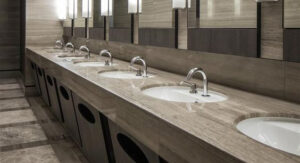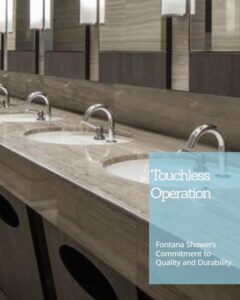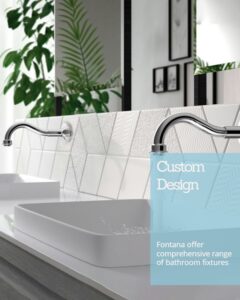Public Bathroom Design – Sustainability
Promoting sustainability through advanced features like the automatic shut-off function in Fontana touchless bathroom faucets offers several compelling reasons for architects and designers to choose these products. Here’s a detailed look at how this feature can attract their interest:
1. Water Conservation and Sustainability
- Reduction in Water Waste: The automatic shut-off feature ensures that water is only used when needed, significantly reducing the amount of water wasted. This is crucial in regions facing water scarcity and aligns with global sustainability goals.
- Environmental Impact: By conserving water, these faucets help reduce the environmental footprint of buildings, contributing to greener, more sustainable architecture. This can be an attractive selling point for environmentally conscious clients and stakeholders.
2. Economic Benefits
- Cost Savings: Reduced water consumption leads to lower utility bills. Over time, the cost savings can be substantial, making these faucets a financially sound investment for building owners and operators.
- Increased Property Value: Sustainable features can enhance the value of a property. Buildings equipped with water-saving technologies are often more appealing to buyers and tenants looking for eco-friendly options.
3. Enhanced User Experience
- Convenience: The touchless operation provides a seamless and modern user experience. The precise and responsive sensor technology ensures that water flows immediately when needed, enhancing convenience and usability.
- Maintenance and Longevity: Touchless faucets generally require less maintenance as there are fewer mechanical parts subject to wear and tear. This can lead to reduced maintenance costs and longer lifespan of the fixtures.
4. Hygiene and Health Benefits
- Minimized Risk of Cross-Contamination: In public restrooms, healthcare facilities, and homes with multiple users, the touchless feature is crucial for maintaining hygiene. It prevents users from touching the faucet, thereby reducing the spread of germs and bacteria.
- Compliance with Health Standards: For architects and designers working on projects in healthcare and other sensitive environments, incorporating touchless faucets can help meet stringent health and safety regulations.
5. Aesthetic and Design Flexibility
- Modern and Sleek Design: Touchless faucets offer a contemporary look that can enhance the overall aesthetic of a bathroom. This appeals to designers looking to create stylish and modern spaces.
- Customization Options: Many touchless faucets come in various designs, finishes, and styles, providing flexibility to match different architectural and interior design themes.
6. Market Differentiation and Branding
- Sustainable Branding: Incorporating sustainable features like touchless faucets allows architects and designers to brand their projects as eco-friendly and innovative. This differentiation can attract clients who prioritize sustainability in their projects.
- Leadership in Sustainability: Architects and designers who consistently incorporate sustainable solutions can position themselves as leaders in green building practices, enhancing their reputation and attracting new business opportunities.
Conclusion
Promoting sustainability through features like the automatic shut-off in Fontana touchless bathroom faucets not only aligns with environmental goals but also offers tangible benefits in terms of cost savings, user experience, hygiene, and design flexibility. These advantages make such faucets an appealing choice for architects and designers looking to create sustainable, efficient, and attractive spaces. By integrating these advanced technologies, they can deliver projects that are not only environmentally responsible but also meet the evolving needs and expectations of users and clients.
Browse Related Articles:
- Choosing the Right Touchless Faucets for Airport Restrooms
- Measurements of the Impact of the FontanaShowers Faucets on Satisfaction of Users
- The Best Brands for Touchless Faucets in Public Restrooms
- 5 Best Hands-Free Faucets For Airports
- Fontana Touchless Faucets and Soap Dispensers Adopted in Airport Facilities
- Fontana Airport Touchless Faucets
- Fontana Airport Faucets on Architizer



